The Chinese government is attempting to perpetuate a snow job on the world — literally.
With the Beijing Winter Olympics set to begin in less than three weeks in one of the driest parts of China, and a lack of snow has organizers humiliated and racing to coat ski runs with man-made snow.
The white patches of snow — fabricated and natural — contrasting against the arid region’s brown mountains are but the latest headache for a Chinese government already dealing with pandemic-related challenges impacting the winter games of the 24th Olympiad, including the more contagious but apparently less-virulent omicron variant of the virus that is fueling infections globally.
China is battling multiple coronavirus outbreaks in at least a half-dozen cities, with the government doubling down on its “zero-tolerance” COVID-19 policy that has more than 20 million people in some form of lockdown across the country, with many prevented from leaving their homes.
Strict containment measures are planned for the Beijing Olympics — including fans being asked to clap instead of shouting or singing — as a means of keeping the virus under control.
Speaking of fans, the quadrennial sporting event meant to bring nations together will ironically be a decidedly Chinese-only affair because spectators from overseas won’t be allowed due to the pandemic.
As for the made-in-China snow, the artificial white stuff is created by local reservoirs feeding into an army of “snow guns” which mix the water with compressed air to create the snow, which is then spread over various course elements by an array of workers.
An International Olympic Committee evaluation report said Zhangjiakou and Yanqing — the zones hosting alpine skiing, snowboarding and other outdoor events — “would rely completely on artificial snow,” according to a report from France 24, a state-owned international news television network based in Paris.
The report itself states Beijing “underestimated the amount of water that would be needed for snowmaking for the Games” and “overestimated the ability to recapture water used for snowmaking.”
While creating the snow is relatively easy, its cost could be harder to bear. Water shortages may be exacerbated by having a reported 49 million of gallons stripped from reserves for an event government officials hope will burnish the image of China, the nation where COVID-19 originated and spread to the rest of the world.
A study conducted last year and published in Nature concluded that groundwater has been badly depleted in northern China related to urbanization and irrigation, leading to water shortages for local residents.
The prospect of further water shortages due to the Olympics casts doubt on China’s claim the games will be “green.”
Olympic athletes themselves seemed decidedly less concerned about the artificial snow, which has been a reality since the 1980 Winter Olympics in Lake Placid, New York.
“The snow is going to be similar to Russia and similar to PyeongChang in the 2018 Olympics. They both had artificial snow in parts,” British snowboarder Charlotte Bankes told the Daily Mail.
“As riders we need to adapt,” she continued, “but we have all been here before.”
Nevertheless, several people expressed concerns over the environmental and human cost to creating fake snow for the Olympics.
Fake snow. Noise pollution. Extreme energy use. #Beijing2022 “could be the most unsustainable Winter Olympics ever held.”-Prof. @CarmenDeJong3 in article on Olympic greenwashing by @feistyredhair @treehugger https://t.co/t62mmkIoxe
— Jules Boykoff (@JulesBoykoff) January 12, 2022
100% artificial snow for Winter Olympics mountain venues north of Beijing. The region only sees 8-inches of snowfall per year.
With climate change, more artificial snow is necessary to maintain critically endangered ski slopes soon to be wiped out.
https://t.co/7x6G3Ls8eE— Ryan | Forecast (@RyanMaue) January 7, 2022
The 2022 Winter Olympics are set to run from Feb. 4 through Feb. 20.
This article appeared originally on The Western Journal.

























 Continue with Google
Continue with Google